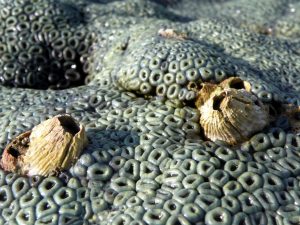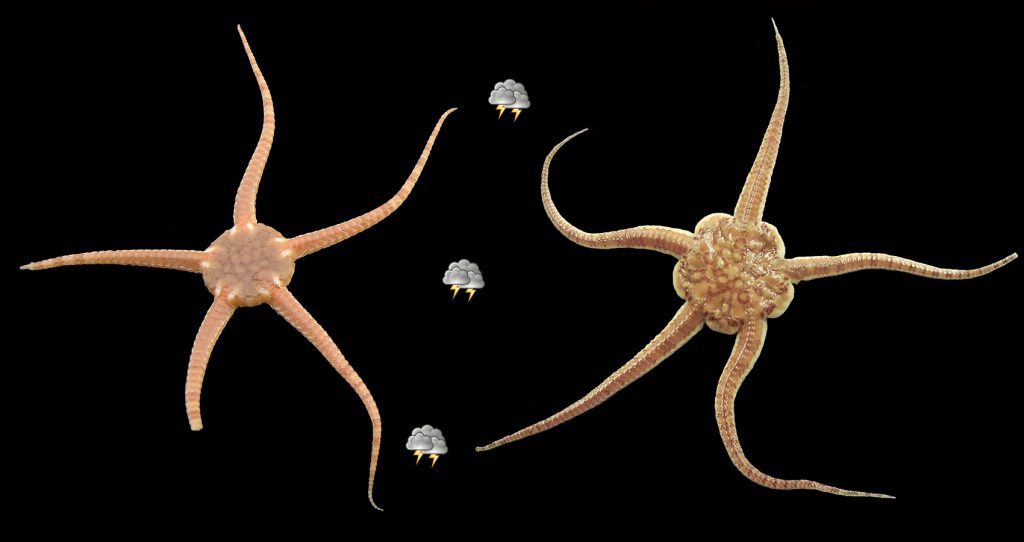
Look around in nature or even in the city and you will see that organisms are not static entities, but interact with one another. Think of a robin with a worm in its beak, a tick crawling on your leg looking for a spot to puncture your skin, or two bucks fighting during the rutting season for the right to mate. The sea floor is also a place where animals search or fight for food to stay alive. On the continents, food is not unlimited; every individual tries to collect a piece of the pie (Fig. 1).

Individuals of the same species have a fairly similar diet so they compete with each other for food, particularly when food is sparse. One example are individuals of a snail species drilling into bivalve shells to access the soft tissue after many hours of drilling. However, bivalves are also eaten by other organisms such as crabs. There is not only competition for food, but also for space. Examples include moss animals (or bryozoans) competing with each other for space on a rock or other substrate or the battle for space between cnidarians and barnacles (Fig. 2).
Strong competition
There is no doubt that competition occurs, but less is known about the strength and importance of competition affecting ecosystems. The latter is not easy to get at for living organisms because the role of each organism in the ecosystem needs to be well-known. It is even more difficult for fossil ecosystems because the diet is not fully understood for each species and not all animals have the same preservation potential. Nevertheless, paleontologists have attempted to find evidence for competition between taxa. For example, they have investigated the diversity and abundance through time of two groups thought to have competed with each other by having lived at about the same time and place and having had a similar diet. For example, Sepkoski and colleagues (2000) showed that cyclostome bryozoans became much more diverse in the Cretaceous and Cenozoic, while cheilostome bryozoan diversity declined. Strong competition between these two groups with cyclostomes as the winner is an explanation for this pattern.
Extreme competition
An extreme type of competition in which one species rarely co-occurs or does not co-occur with another species within the same ecosystem as a result of competition is called competitive exclusion. This extreme competition can be assessed, even for ancient ecosystems. Needed are many samples of an ecosystem with specimens determined to the species-level to investigate evidence for competitive exclusion statistically. This method has been used for some time in ecology, but rarely in paleontology thus far. Luckily, there is sufficient data for modern and ancient sea floors from many places on Earth. Let’s use this data! After some programming so that the observed frequency of co-occurrence versus the expected frequency of co-occurrence for each species pair is statistically evaluated, computers were set to work for hundreds of hours in total to do analyses for all pairs of all datasets. The computers got hot!
Sea floor
The results clearly indicate that competitive exclusion is very rare on ocean bottoms today. The same holds true for ancient sea floors, despite the fact that diversity and presumable animal density has increased in the last ~550 million years to the extent that enhanced competitive interaction may be expected. In rare cases where species pairs occur less frequently than expected by chance, worms and amphipod arthropod pairs are involved. These taxa are known to compete heavily for resources today. The overall result does not change when only mollusks, a group that is abundant in both modern and fossil datasets, are used for the analysis.
Now let’s look at competitive exclusion from a different angle. Competition is likely to be stronger among related taxa, such as species within the same genus because such taxa often have a similar life habit, diet, and dispersal ability. Conversely, species that are only very distantly related, a clam and a lobster for example, often have a very different ecology. Strong competition between these species is unlikely to occur. This so-called competition-relatedness hypothesis was already mentioned by Charles Darwin, but has rarely been tested so far. To test this hypothesis for the sea floor, the computer was put to work again. As expected, distantly related species pairs rarely showed evidence for competitive exclusion, but the same result was also found for species within the same genus. There is one exception: in relatively deep waters, elevated levels of competitive exclusion were detected such as among species pairs of brittle stars (Fig. 3) and again worms and amphipods. This result is based entirely on data from the modern English Channel between France and England; not enough data from deeper waters was available for other areas.

Predators and storms
So why is competitive exclusion very rare? The most likely explanations are that storms and predators damp strong competition between species. A storm may cause an organism to be displaced or killed, while predators injure or kill specimens so that space opens up in ecosystems. As a result, competing species co-occur more frequently relative to a situation where competition is the dominant or only force. The influence of storms and predators is lower in deep waters so that competition may be more important there. This could be the reason why elevated levels of competitive exclusion were found in deep waters in the English Channel. Do the results mean that competition is not happening in shallow waters? No, competition is certainly also common there, but an extreme type of competition leading to competitive exclusion is seldomly seen in these environments.
References
- Klompmaker, A.A. & Finnegan, S., 2018. Extreme rarity of competitive exclusion in modern and fossil marine benthic ecosystems. Geology 46: 723–726. https://doi.org/10.1130/G45032.1
- Sepkoski, J.J., McKinney, F.K. & Lidgard, S., 2000. Competitive displacement among post-Paleozoic cyclostome and cheilostome bryozoans. Paleobiology 26: 7–18. https://bit.ly/2OP2LCi